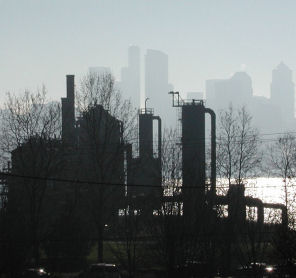Big thanks go to the NY Times for finally putting away the myth of clean coal. Their opinion concludes:
 Burning coal puts out 130 million tons of ash pollution per year.
Burning coal yields fly ash, bottom ash, flue gas, desulfurization
sludge, that all contain
mercury, uranium, thorium, arsenic, and other heavy metals that fall to
the ground polluting streams and groundwater. A coal plant puts more
radiation into the air than a normal nuclear power plant.
Burning coal puts out 130 million tons of ash pollution per year.
Burning coal yields fly ash, bottom ash, flue gas, desulfurization
sludge, that all contain
mercury, uranium, thorium, arsenic, and other heavy metals that fall to
the ground polluting streams and groundwater. A coal plant puts more
radiation into the air than a normal nuclear power plant.
The Grey Lady - perhaps tinged with coal dust - has cautiously understated the dangers of coal.
Beyond the ashes are the gases. Burning coal releases carbon dioxide, nitrogen oxides, sulfur dioxide, carbon monoxide and other hydrocarbons and organic compounds into the atmosphere. This radically increases global warming and degrades the ozone layer. And not just a little bit.
Anyone can do the math - just multiply by 3.6 - even the NY Times can do that. We might just glance at the science behind the calculations. A CO2 molecule is made up of one atom of carbon and two of oxygen. During combustion oxygen from the air, combines with carbon in the coal. The total weight of carbon plus oxygen in carbon dioxide is 3.6 times heavier than the weight of coal before combustion.
This is a very important concept to grasp with any carbon fuel. They will vary some; the coal number is an average since there is so much range in coal quality. So we see the total amount of CO2 released when we multiply the weight of coal by 3.6
The World Coal institute says 5,543,000,000 tons combusted globally in 2007. This means that 5,543,000,000 x 3.6 = 199,548,000,000 CO2
Globally 200 billion (B) tons of carbon dioxide come from coal alone. And just for the year 2007. Pretty simple math - an astounding number, please check my math. Much data comes from industry or government sites.
 So how much CO2 are you and I responsible for generating? Well lets take one single light bulb.
So how much CO2 are you and I responsible for generating? Well lets take one single light bulb.
One web site calculated the amount of coal needed to power one 200 watt light bulb for one year as 1852 pounds. And doing the math again... 3.6 x 1852 = 6667.2 pounds of CO2 for that one light bulb for a year.
Now one ton is 2,240 lbs. So just a little more math: 6667.2/2000 = 3.33 tons. Let's round off and conclude that one 200 watt light bulb enables a yearly output of 3 tons of CO2 into the atmosphere.
Coal ash by light bulb is another calculation. Go ahead - give it a try.
Excuse me, I think I left the light on in the kitchen.
==== notes ===
From 50% to 92% of the total weight of coal is carbon, but each CO2 molecule weighs 3.6 times more than one carbon atom so typical coal might produce around 3 tons of CO2 if burned.
http://www.carbonzerocoal.com/
=========
http://www.fueleconomy.gov/Feg/co2.shtml
How can 6 pounds of gasoline create 19 pounds of Carbon dioxide? It seems impossible that a gallon of gasoline, which weighs about 6.3 pounds, could produce 20 pounds of carbon dioxide (CO2) when burned. However, most of the weight of the CO2 doesn't come from the gasoline itself, but the oxygen in the air.
When gasoline burns, the carbon and hydrogen separate. The hydrogen combines with oxygen to form water (H2O), and carbon combines with oxygen to form carbon dioxide (CO2). CO2 molecule with one carbon atom (atomic weight 12) and two oxygen atoms (atomic weight of 16 each) A carbon atom has a weight of 12, and each oxygen atom has a weight of 16, giving each single molecule of CO2 an atomic weight of 44 (12 from carbon and 32 from oxygen).
Therefore, to calculate the amount of CO2 produced from a gallon of gasoline, the weight of the carbon in the gasoline is multiplied by 44/12 or 3.7.
Since gasoline is about 87% carbon and 13% hydrogen by weight, the carbon in a gallon of gasoline weighs 5.5 pounds (6.3 lbs. x .87).
We can then multiply the weight of the carbon (5.5 pounds) by 3.7, which equals 20
========
Amount of coal needed to power one 200 watt light bulb for one year - almost one ton.
(1852 pounds) http://science.howstuffworks.com/question481.htm
========
http://en.wikipedia.org/wiki/Coal
http://www.worldcoal.org/assets_cm/files/PDF/coalfacts08.pdf
http://climateprogress.org/2009/01/22/us-carbon-dioxide-emissions-growth-bush-china-co2/
"... coal remains an
inherently dirty fuel, and a huge contributor to not only ground-level
pollution -- including acid rain and smog -- but also global warming. The
sooner the country
understands that, the closer it will be to mitigating the damage."
http://www.nytimes.com/2009/01/23/opinion/23fri3.html?th&emc=th
http://www.nytimes.com/2009/01/23/opinion/23fri3.html?th&emc=th
 Burning coal puts out 130 million tons of ash pollution per year.
Burning coal yields fly ash, bottom ash, flue gas, desulfurization
sludge, that all contain
mercury, uranium, thorium, arsenic, and other heavy metals that fall to
the ground polluting streams and groundwater. A coal plant puts more
radiation into the air than a normal nuclear power plant.
Burning coal puts out 130 million tons of ash pollution per year.
Burning coal yields fly ash, bottom ash, flue gas, desulfurization
sludge, that all contain
mercury, uranium, thorium, arsenic, and other heavy metals that fall to
the ground polluting streams and groundwater. A coal plant puts more
radiation into the air than a normal nuclear power plant. The Grey Lady - perhaps tinged with coal dust - has cautiously understated the dangers of coal.
Beyond the ashes are the gases. Burning coal releases carbon dioxide, nitrogen oxides, sulfur dioxide, carbon monoxide and other hydrocarbons and organic compounds into the atmosphere. This radically increases global warming and degrades the ozone layer. And not just a little bit.
( You say you are not sure that CO2 causes global warming?
Well it does. Every sane
scientist on the planet knows and accepts this as fact, and if you
don't then most of those scientists regard you as an ignorant,
dangerous zealot. )
Anyone can do the math - just multiply by 3.6 - even the NY Times can do that. We might just glance at the science behind the calculations. A CO2 molecule is made up of one atom of carbon and two of oxygen. During combustion oxygen from the air, combines with carbon in the coal. The total weight of carbon plus oxygen in carbon dioxide is 3.6 times heavier than the weight of coal before combustion.
This is a very important concept to grasp with any carbon fuel. They will vary some; the coal number is an average since there is so much range in coal quality. So we see the total amount of CO2 released when we multiply the weight of coal by 3.6
The World Coal institute says 5,543,000,000 tons combusted globally in 2007. This means that 5,543,000,000 x 3.6 = 199,548,000,000 CO2
Globally 200 billion (B) tons of carbon dioxide come from coal alone. And just for the year 2007. Pretty simple math - an astounding number, please check my math. Much data comes from industry or government sites.
 So how much CO2 are you and I responsible for generating? Well lets take one single light bulb.
So how much CO2 are you and I responsible for generating? Well lets take one single light bulb.One web site calculated the amount of coal needed to power one 200 watt light bulb for one year as 1852 pounds. And doing the math again... 3.6 x 1852 = 6667.2 pounds of CO2 for that one light bulb for a year.
Now one ton is 2,240 lbs. So just a little more math: 6667.2/2000 = 3.33 tons. Let's round off and conclude that one 200 watt light bulb enables a yearly output of 3 tons of CO2 into the atmosphere.
Coal ash by light bulb is another calculation. Go ahead - give it a try.
Excuse me, I think I left the light on in the kitchen.
==== notes ===
From 50% to 92% of the total weight of coal is carbon, but each CO2 molecule weighs 3.6 times more than one carbon atom so typical coal might produce around 3 tons of CO2 if burned.
http://www.carbonzerocoal.com/
=========
http://www.fueleconomy.gov/Feg/co2.shtml
How can 6 pounds of gasoline create 19 pounds of Carbon dioxide? It seems impossible that a gallon of gasoline, which weighs about 6.3 pounds, could produce 20 pounds of carbon dioxide (CO2) when burned. However, most of the weight of the CO2 doesn't come from the gasoline itself, but the oxygen in the air.
When gasoline burns, the carbon and hydrogen separate. The hydrogen combines with oxygen to form water (H2O), and carbon combines with oxygen to form carbon dioxide (CO2). CO2 molecule with one carbon atom (atomic weight 12) and two oxygen atoms (atomic weight of 16 each) A carbon atom has a weight of 12, and each oxygen atom has a weight of 16, giving each single molecule of CO2 an atomic weight of 44 (12 from carbon and 32 from oxygen).
Therefore, to calculate the amount of CO2 produced from a gallon of gasoline, the weight of the carbon in the gasoline is multiplied by 44/12 or 3.7.
Since gasoline is about 87% carbon and 13% hydrogen by weight, the carbon in a gallon of gasoline weighs 5.5 pounds (6.3 lbs. x .87).
We can then multiply the weight of the carbon (5.5 pounds) by 3.7, which equals 20
========
Amount of coal needed to power one 200 watt light bulb for one year - almost one ton.
(1852 pounds) http://science.howstuffworks.com/question481.htm
========
http://en.wikipedia.org/wiki/Coal
http://www.worldcoal.org/assets_cm/files/PDF/coalfacts08.pdf
http://climateprogress.org/2009/01/22/us-carbon-dioxide-emissions-growth-bush-china-co2/